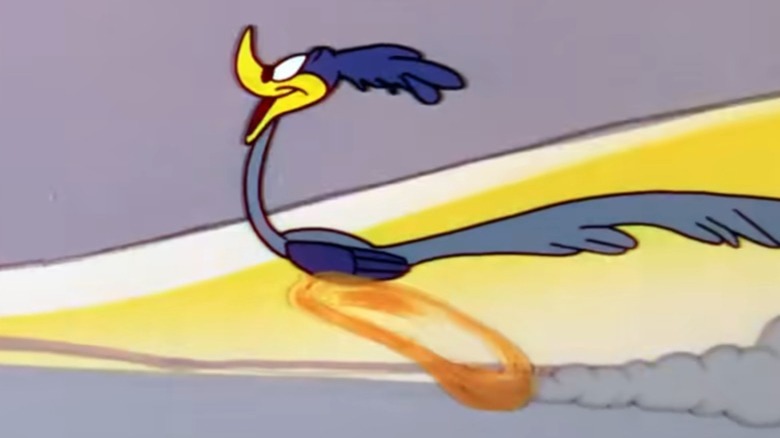Chuck Jones' Rules For The Coyote And Road Runner Explain Why The Characters Worked
Nothing illustrates perseverance in the face of failures quite like the Road Runner and Wile E. Coyote cartoons. The famous cartoon characters' constant conflict has delighted generations of viewers; more than just a Saturday morning staple, their presence goes back to the late '40s. Creators Chuck Jones and Michael Maltese brought the first Wile E. Coyote/Road Runner cartoon, titled "Fast and the Furry-ous," to audiences in 1949.
Jones, a legend in the animation community, would later talk about his own connection to the famous coyote. The animator felt all of his characters were a part of him in some way. Still, there were two characters that stood out for him. "Particularly Daffy [Duck] and the coyote, because they made the kind of mistakes that most of us make only multiplied a bit," he told NPR in an interview in 1989.
Be it Daffy Duck or Wile E. Coyote, Jones was adamant that his cartoons stay true to certain points. And when it came to the Coyote vs. Road Runner competition, the rules did more than create a world for the character — they helped frame narratives and themes that still keep audiences laughing along with every scene.
Jones and Maltese's recollections differ about the rules
Cartoon hijinks are not exactly the first place someone would look to for rules, but there is strict order within the chaos Chuck Jones created. Most important to Jones was a set of guidelines that would ensure the success of this comical pairing; the animator revealed them as part of his book "Chuck Amuck: The Life and Times of an Animated Cartoonist."
Interestingly in regard to Jones' recollections about the rules and their enforcement, there was one person who didn't remember the situation quite the same way. Writer Michael Maltese, who played a role in the cartoons' success, offered his take on Jones' admission. The writer stated he had never heard of these rules during a "Hollywood Cartoons: American Animation in its Golden Age" interview (via Mental Floss).
Whatever the truth of its usage, the nine rules offer a glimpse into Jones' process, one that fans of the cartoon seem to love – @AmosPosner's tweet about the rules still gets retweeted by fans who like Jones' sentiment. They also shine a light on the complex machinations running behind something that many viewers take for granted. It all comes down to ensuring the cartoon characters stay true to the goal of entertainment without sacrificing quality.
The rules offer a glimpse into cartoon history
The rules themselves are easy to understand; Chuck Jones wrote them all out for future animators and fans alike to learn from. In a nod to animation's art form, the creator's rules were put on display at MoMA for a limited engagement. Here are the nine rules for Wile E. Coyote and Road Runner:
Rule 1: The Road Runner cannot harm the Coyote except by going "Beep Beep!"
Rule 2: No outside force can harm the Coyote — only his own ineptitude or the failure of the ACME products.
Rule 3: The Coyote could stop anytime — If he were not a fanatic. (Repeat: "A fanatic is one who redoubles his effort when he has forgotten his aim." — George Santayana)
Rule 4: No dialogue ever, except "Beep Beep!"
Rule 5: The Road Runner must stay on the road — otherwise, logically, he would not be called Road Runner
Rule 6: All action must be confined to the natural environment of the two characters — The Southwest American Desert.
Rule 7: All materials, tools, weapons, or mechanical conveniences must be obtained by the ACME corporation.
Rule 8: Whenever possible, make gravity the Coyote's greatest enemy.
Rule 9: The Coyote is always more humiliated than harmed by his failures.


